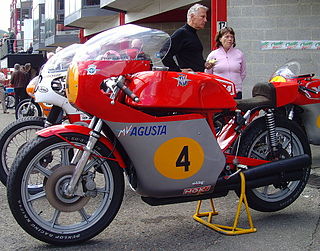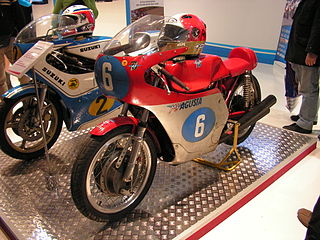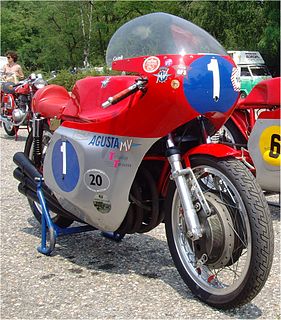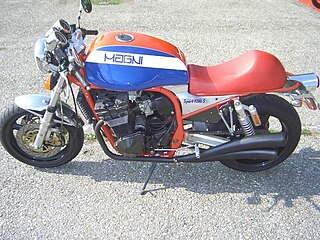
John Surtees, was a British Grand Prix motorcycle road racer and Formula One driver. He was a four-time 500 cc motorcycle World Champion – winning that title in 1956, 1958, 1959 and 1960 – the Formula One World Champion in 1964, and remains the only person to have won World Championships on both two and four wheels. He founded the Surtees Racing Organisation team that competed as a constructor in Formula One, Formula 2 and Formula 5000 from 1970 to 1978. He was also the ambassador of the Racing Steps Foundation.

MV Agusta is a motorcycle manufacturer founded by Count Domenico Agusta on 19 January 1945 as one of the branches of the Agusta aircraft company near Milan in Cascina Costa, Italy. The abbreviation MV stands for Meccanica (mechanics) Verghera, the hamlet where the first MVs were made. The modern headquarters and main production facilities are located in Varese, Italy on the shore of Lake Varese.
The 1957 Grand Prix motorcycle racing season was the ninth F.I.M. Road Racing World Championship Grand Prix season. The season consisted of six Grand Prix races in five classes: 500cc, 350cc, 250cc, 125cc and Sidecars 500cc. It began on 19 May, with German Grand Prix and ended with Nations Grand Prix in Italy on 1 September.
Robert Leslie (Les) Graham was a British motorcycle road racer who competed in the 1930s and 1940s. He won the inaugural Grand Prix motorcycle racing 500 cc World Championship in 1949.

The Moto Guzzi V8, or the Otto motorcycle was designed by Giulio Cesare Carcano specifically for the Moto Guzzi Grand Prix racing team for the 1955 to 1957 seasons. Though following the two-stroke Galbusera V8 of 1938, the Moto Guzzi Otto motorcycle and its engine represent a unique and historically significant engineering milestone.
The 1957 Isle of Man Tourist Trophy was the Golden Jubilee event and the second race in the 1957 Motorcycle World Championships.

Robert MacGregor McIntyre was a Scottish motorcycle racer. The first rider to achieve an average speed of 100 mph (160 km/h) for one lap of the Snaefell Mountain Course in 1957, McIntyre is also remembered for his five motorcycle Grand Prix wins which included three wins at the Isle of Man TT races, and four victories in the North West 200. He died nine days after injuries sustained racing at Oulton Park, Cheshire, England in August 1962.

The MV Agusta 500cc Three (1965-1973) or MV Agusta Tre was a road racing motorcycle produced by the Italian manufacturer MV Agusta to compete in the 500 cc Grand Prix motorcycle racing World Championship. The motorcycle was introduced in 1966 to compete against the ever competitive Honda racing machines and was a bored out version of MV Agusta's highly successful 350 cc three cylinder. Giacomo Agostini won consecutive world championships in the 500 cc class with this motorbike from 1966 to 1972. In addition, MV Agusta won the Constructors' World Championships from 1967 to 1972. The MV Agusta Tre is considered the most successful racing motorcycle in history.

The MV Agusta 500cc road racers were motorcycles that the manufacturer MV Agusta built and which were used to compete in 500cc Grand Prix motorcycle racing series between 1950 and 1976. 18 500cc world championship titles were achieved with these machines ridden by John Surtees, Gary Hocking, Mike Hailwood, Giacomo Agostini and Phil Read between 1958 and 1974.

The MV Agusta 500 four-cylinder (1973-1976) was a racing motorcycle manufactured by the Italian company MV Agusta, for competing in the 500 cc series, the premier class of the FIM World Motorcycle Championship. With this motorcycle MV Agusta won the 1973 constructor's world champion and Phil Read won the 1973 and 1974 500 cc riders world championships.

The MV Agusta 350 cc racers were motorcycles produced by MV Agusta between 1954 and 1976 and raced in the 350 cc motorcycle GP championships. 10 world titles were achieved by riders John Surtees, Gary Hocking and Giacomo Agostini on these machines.

The MV Agusta 350 6 cilindri was a prototype racing motorcycle built by the Varese company MV Agusta in 1957, for the 350 cc class of the FIM Motorcycle World Championship. The project was resurrected in 1968. Neither version was ever used in a race. The only surviving model is now in the MV Agusta factory museum.
The MV Agusta 250 Monocilindrica Bialbero was a 250 cc factory racer manufactured by the Italian brand MV Agusta from 1956 to 1959. With this machine 15 GPs, 2 Driver Championships and 2 manufacturers World Championships were won.
The MV Agusta 250 Bicilindrica was a 250 cc factory racing motorcycle manufactured by the Italian brand MV Agusta from 1957 to 1961. With this machine 11 GPs, 2 Driver Championships and 2 manufacturers World Championships were won.
The MV Agusta 203 Bialbero and MV Agusta 220 Bialbero were Italian factory racing motorcycles made by MV Agusta to compete in the 1955 250 cc World Motorcycle Racing Championship. The machine won three GPs and with it MV Agusta won that year's 250 cc Constructors Championship.

The MV Agusta 125 Bialbero was a 125 cc factory racer from the Italian brand MV Agusta, which was used between 1950 and 1960. The machine won 34 GPs, 6 rider's championships and one manufacturer's championship. The machine also won 4 Italian Championships and 10 National Championships in other countries.
Arturo Magni was an Italian engineer racing team manager and entrepreneur.
Piero Remor was an Italian engineer and motorcycle constructor, best known for his work for the Gilera and MV Agusta brands.

Magni is an Italian company that builds specialist motorcycles. The company is based in the city of Samarate in the province of Varese. Magni, in addition to building the bikes that bear its name, is also active in the construction of specials to order and a supplier of special parts for the restoration of MV Agusta classic motorcycles.









